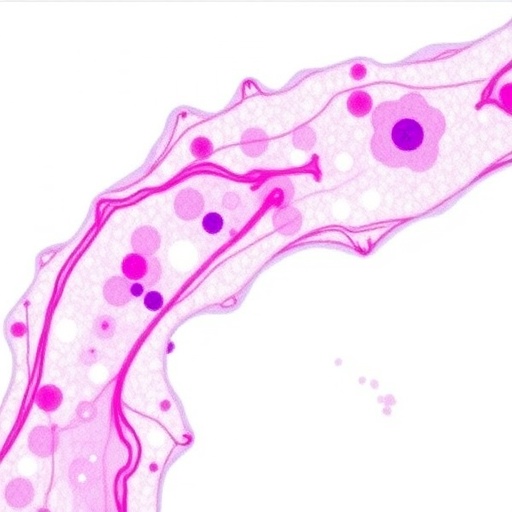
The placenta has long been recognized for its pivotal role in nourishing and protecting the developing fetus during gestation. This vital organ not only facilitates the transfer of nutrients and oxygen but also serves as a barrier, shielding the fetus from harmful pathogens. However, recent research undertaken by Castillo et al. sheds light on the complexity of the placenta’s functions, emphasizing that while it is a competent barrier against certain viral and parasitic threats, it is not infallible. This nuanced perspective invites deeper inquiry into the intricate dynamics between maternal health, fetal protection, and the challenges posed by infectious agents.
The placenta functions as a multifaceted interface between the mother and fetus, allowing for the exchange of substances necessary for fetal development. The selective permeability of the placenta is critical; it permits the passage of essential antibodies, which help to bolster the immune system of the fetus, while blocking potential threats. This selective nature means that the placenta can effectively guard against some pathogens, thereby enhancing fetal safety. However, as highlighted in the recent study, this capability is not absolute.
Viral infections that penetrate the placental barrier challenge the idea of the placenta as an impenetrable shield. Certain viruses, including Zika and cytomegalovirus, have demonstrated the ability to traverse this barrier, affecting fetal development severely. These incursion incidents remind the scientific community that despite the placental barrier’s sophisticated defenses, certain pathogens possess unique mechanisms that allow them to breach these protections. Castillo and colleagues discuss how viral agents may latch onto cell receptors or exploit specific transport mechanisms for their advantage.
Parasites, too, represent a significant concern in this discussion. Toxoplasma gondii, the causative agent behind toxoplasmosis, is particularly notorious for its ability to cross the placenta, potentially leading to severe congenital consequences. This parasite demonstrates how the placental barrier can sometimes misjudge both the threat level and the nature of the adversary within maternal circulation. As such, immunologists and reproductive scientists are urged to consider not only the protective roles of the placenta but also the necessary advancements in maternal-fetal health that can enhance protective measures.
Moreover, the placenta’s innate immune responses are crucial to understanding its antiviral capabilities. A resilient placental immune response can mitigate or even prevent the severe consequences of viral infections. The study elaborates on the cells present in the placenta, including trophoblasts and decidual immune cells, which collectively contribute to this protective effort. Their roles encompass both local immunity against infections and communication with systemic immune responses.
Interestingly, the concept of placental tolerance is also key in this discussion. The placenta must maintain a balance between protecting the fetus and avoiding excessive maternal immune reactions that could lead to complications such as miscarriage or preterm birth. This duality illustrates the complexity of the placenta not merely as a barrier but as an active participant in the immunological landscape of pregnancy. Castillo et al.’s research encourages further exploration into how these physiological adaptations can be harnessed to improve clinical practices surrounding maternal-infant health.
The implications of this research extend beyond individual maternal-fetal health. They touch on public health concerns, given the resurgence of certain infectious diseases in various regions. For instance, heightened vigilance is required in monitoring maternal exposures to viruses that have the potential for vertical transmission. An understanding of the placenta’s limitations enables expectant mothers and healthcare providers to adopt more informed preventive strategies, particularly in areas where these pathogens are endemic.
In addition, the emergence of new or re-emerging viral threats underscores the urgency for continued research into placental biology. Understanding the mechanisms through which various pathogens can bypass the placental barrier aids in the development of therapeutic interventions. Efforts could be directed toward enhancing the resilience of this organ, potentially leading to novel vaccine developments or treatments designed to strengthen placental defenses.
There is no doubt that the recent findings by Castillo et al. compel a reevaluation of how we perceive the placenta. Rather than seeing it solely as a protective barrier, it is crucial to recognize its role in a delicate balance between immunity and tolerance. This ongoing dialogue among researchers will advance our understanding of reproductive health and pregnancy outcomes, paving the way for innovative solutions to safeguard maternal and fetal health.
Educating the public about the placenta’s functions and potential vulnerabilities is also paramount. Misunderstandings or lack of awareness can lead to misinformation about pregnancy risks, highlighting the importance of integrating findings from studies like these into maternal education programs. Expectant mothers should be informed about preventative measures they can take regarding infectious diseases, empowering them to seek timely care and vaccinations when necessary.
In conclusion, while the placenta plays a critical role in protecting the fetus from various pathogens, the recent study by Castillo et al. illuminates the limitations of this barrier. Moving forward, both scientific research and healthcare practices must adapt to these realities to ensure better maternal and fetal health outcomes. The journey of understanding the placenta continues as researchers delve deeper into the myriad functions this remarkable organ serves, striving for breakthroughs that will refine our approach to pregnancy and disease prevention.
Subject of Research: Understanding the placental barrier’s competence against viruses and parasites.
Article Title: Placenta – A Competent, But Not Infallible, Antiviral and Antiparasitic Barrier.
Article References:
Castillo, C., Chi, H.H.J., Ghilardi, L.B. et al. Placenta – A Competent, But Not Infallible, Antiviral and Antiparasitic Barrier.
Reprod. Sci. 32, 2669–2684 (2025). https://doi.org/10.1007/s43032-025-01921-8
Image Credits: AI Generated
DOI: https://doi.org/10.1007/s43032-025-01921-8
Keywords: Placenta, Viral Barrier, Antiparasitic, Immunity, Maternal-Fetal Health, Trophoblasts, Vertical Transmission, Infectious Diseases.
Tags: antiviral properties of the placentachallenges of placental immunityimmune system support via placentalimitations of placental protectionmaternal health and fetal developmentmaternal-fetal interface dynamicsparasitic threats to fetal healthplacenta as a barrier against pathogensplacenta functions in fetal protectionselective permeability of the placentaviral infections during pregnancyZika virus and placenta




